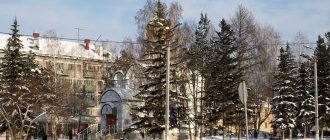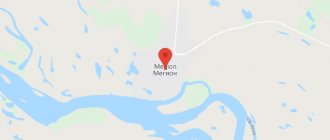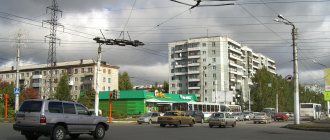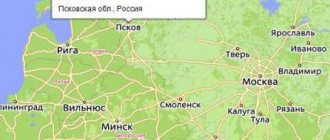Yugorsk appeared on the map of Russia in 1962. At the time of its founding, the settlement was named the Komsomolsky village. It arose at the site of logging in the Khanty-Mansiysk Autonomous Okrug as part of the Tyumen region.
- In 1987, the population reached 20 thousand people, and the village itself was recognized as the best in the district in terms of improvement.
- In 1991, a survey was conducted among the residents of the village about assigning the village the status of a city and renaming it.
- In 1992, Komsomolsky received the status of a city, at the same time it was renamed Yugorsk, after the name of the district.
- The city's population is constantly increasing. In 2022, about 37 thousand people lived in Yugorsk. The area of the city is 152.18 square meters. km.
Geographic information
Geographically, the city is located in the south of the North Sosvinskaya Upland, which belongs to the West Siberian Plain. At a distance of 5 km flows the small river Ess, a tributary of the Konda River. It borders with the Sovetsky district of Khanty-Mansi Autonomous Okrug. The capital of the Autonomous Okrug, Khanty-Mansiysk, is located 420 km away.
The terrain of the territory is predominantly flat, gently hilly. The city is located in the taiga zone, surrounded by forests, with a predominance of coniferous trees and an abundance of mushrooms and berries.
The region is located in a zone of sharply continental climate, with short warm summers and very long and cold winters, which is why the heating season is also long. In terms of natural and climatic working conditions, the territory is equal to the regions of the Far North. In the coldest month, January, the average temperature is plus 17.5 °C, in the coldest - minus 16.5 °C. The average temperature throughout the year is minus 0.7 °C.
General information
Yugorsk, Tyumen region, is located in the western part of the Khanty-Mansiysk Autonomous Okrug. The small town is the administrative center of the district of the same name. It occupies an area of 152.18 km². The population density of the city of Yugorsk is 244.12 people/sq.km.
A monotown, the city-forming enterprise of which is Gazprom Transgaz Yugorsk, a subsidiary of Gazprom that manages the largest gas transportation system in the world. Provides jobs for 30,000 people, of which about 6,000 are Ugra residents, the rest work on a rotational basis.
The city is home to the Geologicheskaya station of the Sverdlovsk Railway, which is capable of handling passenger trains with a length of 500 m and freight trains with a length of 700 m. Transportation is carried out in the direction Sverdlovsk - Priobye. Highways are of local importance only, with a total length of 130.2 km. The nearest airport in the city of Sovetsky is 15 km away.
mass media
The city's media are the newspapers "Yugorsky Vestnik", "Northern Variant" and "Nord". Television and radio. Radio “Nord-FM” also operates in the city, and the magazines “2 Cities” and “Our City Yugorsk” are published[16].
A television
- First channel
- Russia-1 / State Television and Radio Broadcasting Company "Yugoria"
- TV Center
- MIR 24 / Yugorsk TV
- NTV
- Channel Five (Yugorsk TV)
- REN TV / TRC "Nord"
- TV-3
- Ugra
- Russia K
Radio stations
- 87.8 FM - Radio Chanson plan
- 90.1 FM – Radio Record
- 101.6 FM – Russian radio
- 104.00 FM - Road Radio
- 102.5 FM – Radio Yugra
- 102.9 FM – Love Radio / Retro FM plan
- 105.8 FM - Europe Plus
- 106.8 FM - Nord FM
- 107.3 FM - Radio "Radio"
- 71.78 VHF-FM Radio Russia
Founding of the settlement
The first population of Yugorsk was a team of 17 logging workers who reached these remote places at that time to harvest timber necessary for the construction of the Ivdel-Ob railway. This happened on March 21, 1962, although now the city’s birthday is celebrated on the first Saturday of September. It was planned to organize an Ess station at 175 km of the railway. Later, the next batch of workers arrived - tractor drivers and fellers. On the basis of the logging station, the Essky timber industry enterprise was formed, which in October 1962 was renamed Komsomolsky.
Quite quickly, the timber industry enterprise became a large diversified enterprise, which was engaged not only in timber harvesting, but also in its processing and harvesting of resin. The advanced enterprise became a pioneer in the introduction of new technology. The village grew quickly, the population increased, people from all regions of the large country came here to work. The first streets of the settlement were clearings lined with barracks and dugouts.
Construction
The priority direction in the policy of the city authorities is construction, which is why Yugorsk is being actively built up today. Comfortable residential buildings are being erected, the second stage of an overpass across the railway is being built, the buildings of a branch of the St. Petersburg State Electrotechnical University, a department store are being reconstructed, and other objects necessary for the townspeople are being erected. City authorities are working to attract builders from other regions. In recent years the following have been built:
Source
Foundation of the city
In 1962, railway tracks were laid to Ess station. During these same years, colossal reserves of hydrocarbons were explored in the north of the region and the industrial development of oil and gas fields began. In 1964, the Directorate for Gas Pipeline Construction moved to the village of Komsomolsky, now JSC Gazprom Transgaz Yugorsk, which was engaged in the construction of the Igrim-Serov gas pipeline. In October 1966, a 220 km section of the Ivdel2-Konda railway was put into operation.
By 1970, the population of Yugorsk, at that time the village of Komsomolsky, reached 6,600 people. Young people from all over the Soviet Union came here to work, attracted by the romance of the taiga and good wages. In the 70-80s, the village grew and improved, many new jobs were created due to the increase in logging and gas transportation. By 1979, the population of Yugorsk had doubled, to 12,500 inhabitants. According to the latest data from the Soviet period, 24,900 people lived in the settlement.
"Gateway to Ugra"
In the territory where the city of Yugorsk is located, the Verkhnekondinsky nature reserve, the Kondinskie Lakes natural monument, and the Malaya Sosva nature reserve were created to preserve endangered and rare species of fauna and flora. These are favorite vacation spots not only for Ugra residents. Lovers of summer and winter fishing come here to pick berries and mushrooms, which the forests are rich in. Recreation centers have created conditions for relaxation near picturesque lakes. There you can not only sunbathe and swim, but also go boating and kite surfing.
Near the place where the city of Yugorsk is located, there is a unique open-air museum “Suevat Paul”. It recreates a traditional settlement of the indigenous population with buildings, elements of everyday life, and decoration.
On the basis of “Suevat Paul” it is planned to create a museum and tourist complex “Gateway to Ugra”. After all, they want to make the place where the city of Yugorsk is located a calling card of Yugra. Develop the territory, build a hotel complex, cafes, parking lots and other facilities here to attract tourists. For now, the emphasis is on domestic and business tourism, because it is known that residents of not only neighboring regions, but even neighboring cities rarely travel outside their place of residence.
Modernity
The crisis of the 90s did not greatly affect the city, thanks to the increased demand for gas transportation. The first enterprise that gave rise to the village, the Komsomolsk Timber Industry Enterprise, did not survive the restructuring. In 1992, the village became the city of Yugorsk with a population of 26,500 inhabitants. The number of inhabitants, with the exception of a short period in 2002, is constantly growing.
Currently, the city continues to actively develop. In addition to the city-forming enterprise, there is a brick factory, a clothing factory, and the Yugorskremstroygaz trust. In 2022, the population of Yugorsk was 37,150 people. Most of them are Russians, Ukrainians and Tatars, there are also representatives of the indigenous peoples of the North - Manskis and Khanty. There is an Orthodox church of St. Sergius of Radonezh and a mosque in the city.
Excerpt characterizing Yugorsk
Naked Helen sat next to her and smiled equally at everyone; and Natasha smiled at Boris in the same way. Helen's box was filled and surrounded from the stalls by the most distinguished and intelligent men, who seemed to be vying to show everyone that they knew her. Throughout this intermission, Kuragin stood with Dolokhov in front of the ramp, looking at the Rostovs’ box. Natasha knew that he was talking about her, and it gave her pleasure. She even turned around so that he could see her profile, in her opinion, in the most advantageous position. Before the start of the second act, the figure of Pierre appeared in the stalls, whom the Rostovs had not seen since their arrival. His face was sad, and he had gained weight since Natasha last saw him. Without noticing anyone, he walked into the front rows. Anatole approached him and began to say something to him, looking and pointing at the Rostovs’ box. Pierre, seeing Natasha, perked up and hurriedly, along the rows, went to their bed. Approaching them, he leaned on his elbow and, smiling, spoke to Natasha for a long time. During her conversation with Pierre, Natasha heard a man’s voice in Countess Bezukhova’s box and for some reason learned that it was Kuragin. She looked back and met his eyes. Almost smiling, he looked straight into her eyes with such an admiring, affectionate look that it seemed strange to be so close to him, to look at him like that, to be so sure that he liked you, and not be familiar with him. In the second act there were paintings depicting monuments and there was a hole in the canvas depicting the moon, and the lampshades on the ramp were raised, and trumpets and double basses began to play, and many people in black robes came out to the right and left. People began to wave their arms, and in their hands they had something like daggers; then some other people came running and began to drag away that girl who had previously been in a white, and now in a blue dress. They didn’t drag her away right away, but sang with her for a long time, and then they dragged her away, and behind the scenes they hit something metal three times, and everyone knelt down and sang a prayer. Several times all these actions were interrupted by enthusiastic screams from the audience. During this act, every time Natasha glanced at the stalls, she saw Anatoly Kuragin, throwing his arm over the back of the chair and looking at her. She was pleased to see that he was so captivated by her, and it did not occur to her that there was anything bad in this. When the second act ended, Countess Bezukhova stood up, turned to the Rostovs' box (her chest was completely bare), beckoned the old count to her with a gloved finger, and, not paying attention to those who entered her box, began to speak kindly to him, smiling. “Well, introduce me to your lovely daughters,” she said, “the whole city is shouting about them, but I don’t know them.” Natasha stood up and sat down to the magnificent countess. Natasha was so pleased by the praise of this brilliant beauty that she blushed with pleasure. “Now I also want to become a Muscovite,” said Helen. - And aren’t you ashamed to bury such pearls in the village! Countess Bezukhaya, rightly, had a reputation as a charming woman. She could say what she did not think, and especially flatter, completely simply and naturally. - No, dear Count, let me take care of your daughters. At least I won't be here for long now. And you too. I will try to amuse yours. “I heard a lot about you back in St. Petersburg, and I wanted to get to know you,” she told Natasha with her uniformly beautiful smile. “I heard about you from my page, Drubetsky. Did you hear he's getting married? And from my husband’s friend Bolkonsky, Prince Andrei Bolkonsky,” she said with special emphasis, thereby hinting that she knew his relationship to Natasha. “She asked, in order to get to know each other better, to allow one of the young ladies to sit in her box for the rest of the performance, and Natasha went over to her. In the third act, a palace was presented on stage, in which many candles were burning and paintings depicting knights with beards were hung. In the middle stood probably the king and queen. The king waved his right hand, and, apparently timid, sang something badly and sat down on the crimson throne. The girl, who was first in white, then in blue, was now wearing only a shirt with her hair down and stood near the throne. She sang sadly about something, turning to the queen; but the king sternly waved his hand, and men with bare legs and women with bare legs came out from the sides and began to dance all together. Then the violins began to play very subtly and cheerfully, one of the girls with bare thick legs and thin arms, separated from the others, went backstage, straightened her bodice, went out to the middle and began to jump and quickly beat one leg against the other. Everyone on the ground clapped their hands and shouted “Bravo”. Then one man stood in the corner. The orchestra started playing cymbals and trumpets louder, and this one man with bare legs began to jump very high and mince his feet. (This man was Duport, who received 60 thousand a year for this art.) Everyone in the stalls, in the boxes and in the rai began to clap and shout with all their might, and the man stopped and began to smile and bow in all directions. Then others danced, with bare legs, men and women, then again one of the kings shouted something to the music, and everyone began to sing. But suddenly there was a storm, chromatic scales and diminished seventh chords were heard in the orchestra, and everyone ran and again dragged one of those present backstage, and the curtain fell. Again a terrible noise and crackling arose between the spectators, and everyone with delighted faces began to shout: Dupora! Dupora! Dupora! Natasha no longer found this strange. She looked around her with pleasure, smiling joyfully. – N'est ce pas qu'il est admirable – Duport? [Isn’t Duport amazing?] said Helene, turning to her. “Oh, oui, [Oh, yes,”] Natasha answered. During the intermission, there was a smell of cold in Helen's box, the door opened and, bending down and trying not to catch anyone, Anatole entered. “Let me introduce you to my brother,” Helen said, nervously flicking her eyes from Natasha to Anatole. Natasha turned her pretty head over her bare shoulder to the handsome man and smiled. Anatole, who was as good-looking up close as he was from afar, sat down next to her and said that he had long wanted to have this pleasure, ever since the Naryshkin Ball, at which he had the pleasure, which he had not forgotten, of seeing her. Kuragin was much smarter and simpler with women than in male society. He spoke boldly and simply, and Natasha was strangely and pleasantly struck by the fact that not only was there nothing so terrible about this man about whom they talked so much, but that on the contrary, he had the most naive, cheerful and good-natured smile.








